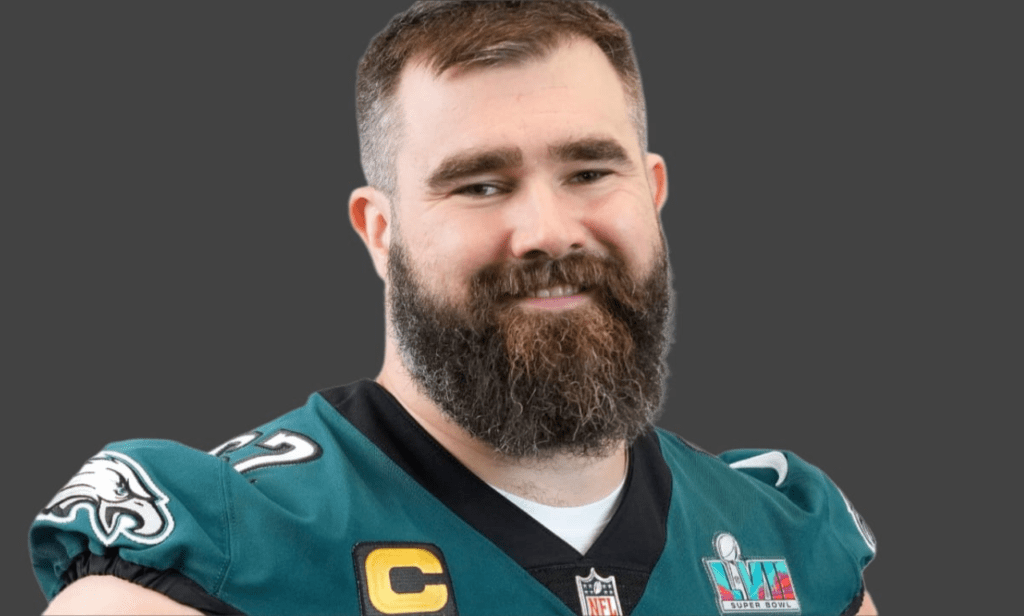
Jason Kelce, the heart and soul of the Philadelphia Eagles for over a decade, recently pulled back the curtain on a reality many retired NFL players face, but few discuss with such raw honesty. The future Hall of Fame center, celebrated for his toughness and durability during 13 grueling seasons, shared a health update that resonated far beyond Philadelphia. It wasn’t about a single injury or a temporary setback. Kelce spoke about the accumulating toll of thousands of collisions, the kind of wear and tear that doesn’t magically disappear when the pads come off for the last time. His revelations paint a sobering picture of life after football, one marked by persistent pain and concerning neurological symptoms that demand attention.
During a recent podcast appearance, Kelce described grappling with issues that extend far beyond the expected aches and pains. While chronic joint pain, particularly in his knees and back, remains a constant companion – “My body feels decades older than it is,” he admitted – it’s the neurological symptoms that raise deeper concerns. Kelce openly discussed experiencing frequent headaches, troubling memory lapses, and unpredictable mood swings. He recounted moments of uncharacteristic irritability and forgetfulness, like struggling to recall where he parked his car, incidents that feel alien and deeply unsettling. “It’s not every day, but when it happens, it stops you cold,” Kelce shared, his voice conveying a mix of frustration and vulnerability. These symptoms, often reported by athletes with a history of repetitive head impacts, point to the complex and often invisible injuries sustained on the gridiron. Kelce emphasized he hasn’t received a specific diagnosis like CTE, which can only be confirmed posthumously, but his experiences align with what neurologists recognize as potential long-term effects of head trauma.
Understanding the significance of Kelce’s symptoms requires looking at the broader context of football-related neurological risks. Chronic Traumatic Encephalopathy (CTE) is a degenerative brain disease linked to repeated blows to the head. Research from institutions like Boston University’s CTE Center, led by Dr. Ann McKee, has found CTE in the brains of a staggering percentage of deceased former NFL players studied. While living diagnoses are complex, symptoms like Kelce describes – persistent headaches, cognitive fog, emotional dysregulation – are red flags. Dr. McKee’s team has consistently shown that it’s not just concussions causing problems, but the cumulative effect of countless sub-concussive hits, the kind of hits linemen like Kelce absorb on virtually every play. Studies tracking retired NFL players indicate significantly higher rates of cognitive impairment and neuropsychiatric symptoms compared to the general population. For instance, research published in the Journal of the American Medical Association found retired NFL players were four times more likely to die from ALS and neurodegenerative diseases. Kelce’s openness brings these stark statistics into the human realm, making the abstract painfully personal.
The physical toll Kelce endures is equally harrowing and emblematic of an NFL lineman’s career. Playing center involves near-constant, high-impact collisions. Imagine the force generated by 300-pound men colliding play after play, game after game, season after season. Kelce detailed multiple surgeries throughout his career – on his knee, elbow, and foot – and the relentless grind that left him with advanced arthritis. “Getting out of bed some mornings feels like a monumental task,” he confessed. This isn’t hyperbole. A landmark study by the National Institute for Occupational Safety and Health (NIOSH) found that NFL players have a dramatically elevated risk of arthritis. Their research indicated that former NFL players develop arthritis at rates three times higher than the general population, often manifesting before age 50. The joint degeneration stems from repetitive stress, ligament damage, cartilage wear, and the inevitable aftermath of surgical interventions. Orthopedic surgeons like Dr. David Chao, former team physician for the San Diego Chargers, explain that the joints of players like Kelce essentially experience accelerated aging. “The trauma they sustain is equivalent to decades of wear compressed into a few years of intense competition,” Dr. Chao notes. “It’s not surprising they face debilitating arthritis relatively early in life.”
Kelce’s candidness about his mental health struggles alongside the physical pain adds another crucial layer. He spoke about the emotional weight of adjusting to retirement while managing chronic health issues, including seeking therapy. This admission is profoundly significant in the macho culture of professional football. Sports psychologists emphasize that the transition out of the NFL is notoriously difficult. Players lose a core part of their identity, structured routine, and intense camaraderie. When this transition is compounded by chronic pain and cognitive concerns, the risk of depression, anxiety, and isolation skyrockets. Dr. Justin Anderson, a psychologist specializing in athlete mental health, underscores the importance of Kelce’s openness: “Acknowledging the need for psychological support breaks down harmful stigma. It shows other players that seeking help isn’t a weakness, but a vital part of managing the complex aftermath of a career built on physical sacrifice.” Kelce’s willingness to discuss therapy highlights the multifaceted nature of player wellness – it’s about the brain and the mind.
Kelce’s update inevitably brings the NFL’s responsibility into sharp focus. While the league has implemented significant rule changes to reduce head injuries (like stricter penalties for helmet-to-helmet hits) and invested millions in research through initiatives like the “Play Smart. Play Safe” campaign, the effectiveness for retired players remains debated. The NFL’s concussion settlement has paid out over $1 billion to former players diagnosed with severe neurological conditions, yet the process has faced criticism for being arduous and sometimes inaccessible. Programs like the Player Care Foundation offer post-career health screenings, but advocates argue more comprehensive, lifelong healthcare support is needed, especially for players from earlier eras exposed to less protective equipment and protocols. Chris Nowinski, Ph.D., co-founder of the Concussion Legacy Foundation, argues Kelce’s story underscores the urgency: “The league benefits immensely from the sacrifices of players. There’s a moral imperative to ensure they are supported long after the cheering stops, particularly for those facing debilitating health consequences directly linked to their time on the field.”
For parents and young athletes, Kelce’s story serves as a critical conversation starter about sports safety. Experts increasingly recommend delaying the introduction of tackle football until adolescence to minimize early head impact exposure. Organizations like USA Football promote modified versions like flag football for younger children and teach “Heads Up” tackling techniques designed to reduce head contact. Dr. Robert Cantu, a leading neurotrauma specialist, advises parents to prioritize coaches who emphasize safe techniques and immediately remove players suspected of having a head injury. “The developing brain is uniquely vulnerable,” Dr. Cantu stresses. “Minimizing repetitive hits during childhood and adolescence is paramount for long-term brain health.”
Despite these challenges, Jason Kelce remains characteristically proactive and engaged in life after football. He’s a dynamic presence on the “New Heights” podcast alongside his brother Travis, connecting with fans in a new way. His charitable work in Philadelphia continues, demonstrating his enduring commitment to the community. Yet, his health update is a powerful, unvarnished testament to the hidden costs of NFL glory. He isn’t seeking pity; he’s fostering awareness. By detailing his daily battles with pain, cognitive fog, and emotional adjustment, Kelce gives a human face to the often-discussed but rarely understood long-term risks of professional football. His courage in sharing this difficult journey provides invaluable insight for current players, the league, medical professionals, and fans alike. It’s a stark reminder that the echoes of those bone-jarring hits on Sunday afternoons can reverberate for a lifetime, demanding attention, research, and compassionate support for the warriors who entertained us. Kelce’s legacy, already cemented by his on-field brilliance and infectious passion, now expands to include a vital role as an advocate for player health and well-being long after the final whistle blows. His honesty chips away at the silence, encouraging others to seek help and pushing the conversation about athlete safety into a brighter, more accountable light.
